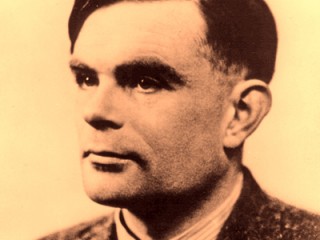
Turing, Alan biography
Date of birth : 1912-06-23
Date of death : 1954-06-07
Birthplace : Wilmslow, Cheshire, England
Nationality : British
Category : Science and Technology
Last modified : 2010-04-23
Credited as : Mathematician/logician, computer scientist and cryptanalyst, Enigma machine
During the Second World War, Turing worked for the Government Code and Cypher School at Bletchley Park, Britain's codebreaking centre. For a time he was head of Hut 8, the section responsible for German naval cryptanalysis. He devised a number of techniques for breaking German ciphers, including the method of the bombe, an electromechanical machine that could find settings for the Enigma machine. After the war he worked at the National Physical Laboratory, where he created one of the first designs for a stored-program computer, the ACE.
Contributing to mathematics, statistics, logic, philosophy, biology, cognitive science, and as the founder of computer science, Alan Turing revolutionized cryptanalysis and the ideas of the day about the possibility of machines becoming sentient. Elected as an esteemed member of the Fellow of the Kings at age 22, all while attending King’s College and inventing his famed Turing-Machine, he would soon be labeled as the greatest code breaker of all time.
Soon after college, Turing began working with mathematician Alonzo Church. Together, the two devised the Turing-Church Thesis. In their time spent together and while working independently, the two were able show that not all math is solvable using effective methods. In the mid-1930s, it was believed that the goal of mathematics was to find an absolute or pure system in which one could plug any formula or equation and it could be proven true to untrue. Turing and Church disproved Hilton’s reigning theory that math would ‘perfect’ itself to an extent – that all problems have a definite solution.
While working on his doctorate under Church, Turing began to theorize that oracular computation could be used as an abstract method to solve mathematical problems too difficult for the Turing Machine.
Upon returning to England with the brink of World War II on the horizon, Alan Turing joined the Government Code and Cypher School at Bletchley Park. While there, he worked on electro-mechanical machines that could be used to decipher the puzzles and codes that were being communicated between England’s war enemies – namely the Nazis. It was in his ability to decipher codes called ‘bombes’ that he was given full security clearance to pursue and perfect his machine. In doing so, Turing’s machine, using binary codes, was able to break nearly 50,000 messages a month – some that Hitler communicated to the German High Command. It is believed that Turing’s machine alone helped end World War II by at least two to more than four years. Some say it would have been impossible to stop Germany without it. For his wartime efforts, he was awarded the Order of the British Empire.
Following the war, Turing worked for the National Physical Laboratory in England. While there, Turing actually designed an electronic digital computer storage center that many call the first true modern computer design. He theorized that speed faster than any human computation and a vast memory storage base were essential to its design. It was his later work with the Ferranti Mark I computer that made computers commercially available. He began working on artificial intelligence, believing that the human brain is actually a universal computer that is programmed after birth. At the height of his work in Artificial Intelligence, Turing suddenly died after he ate an apple laced with cyanide. Investigations have concluded it was suicide, while his family and colleagues claim otherwise.
















